Report on Organizational Change Management at Google Incorporated
VerifiedAdded on 2022/10/19
|15
|3620
|246
Report
AI Summary
This report delves into Google Inc.'s approach to organizational change management, highlighting its strategies for driving innovation and adapting to the dynamic business environment. It examines how Google leverages technological advancements and structural changes to maintain its competitive advantage. The report analyzes Google's organizational structure, emphasizing its flat structure and cross-functional teams, and explores its adoption of a four-step change management model, known as "change rules," to effectively manage change and minimize employee resistance. Furthermore, the report discusses Google's people-centric approach, emphasizing employee empowerment, open communication, and a stimulating work environment to foster creativity and commitment. The analysis includes recommendations for successful change implementation and concludes by emphasizing Google's commitment to continuous change and its impact on the company's innovative culture and long-term success.

Organizational Change 0
Change Management
Student’s Name
9/24/2019
Change Management
Student’s Name
9/24/2019
Paraphrase This Document
Need a fresh take? Get an instant paraphrase of this document with our AI Paraphraser
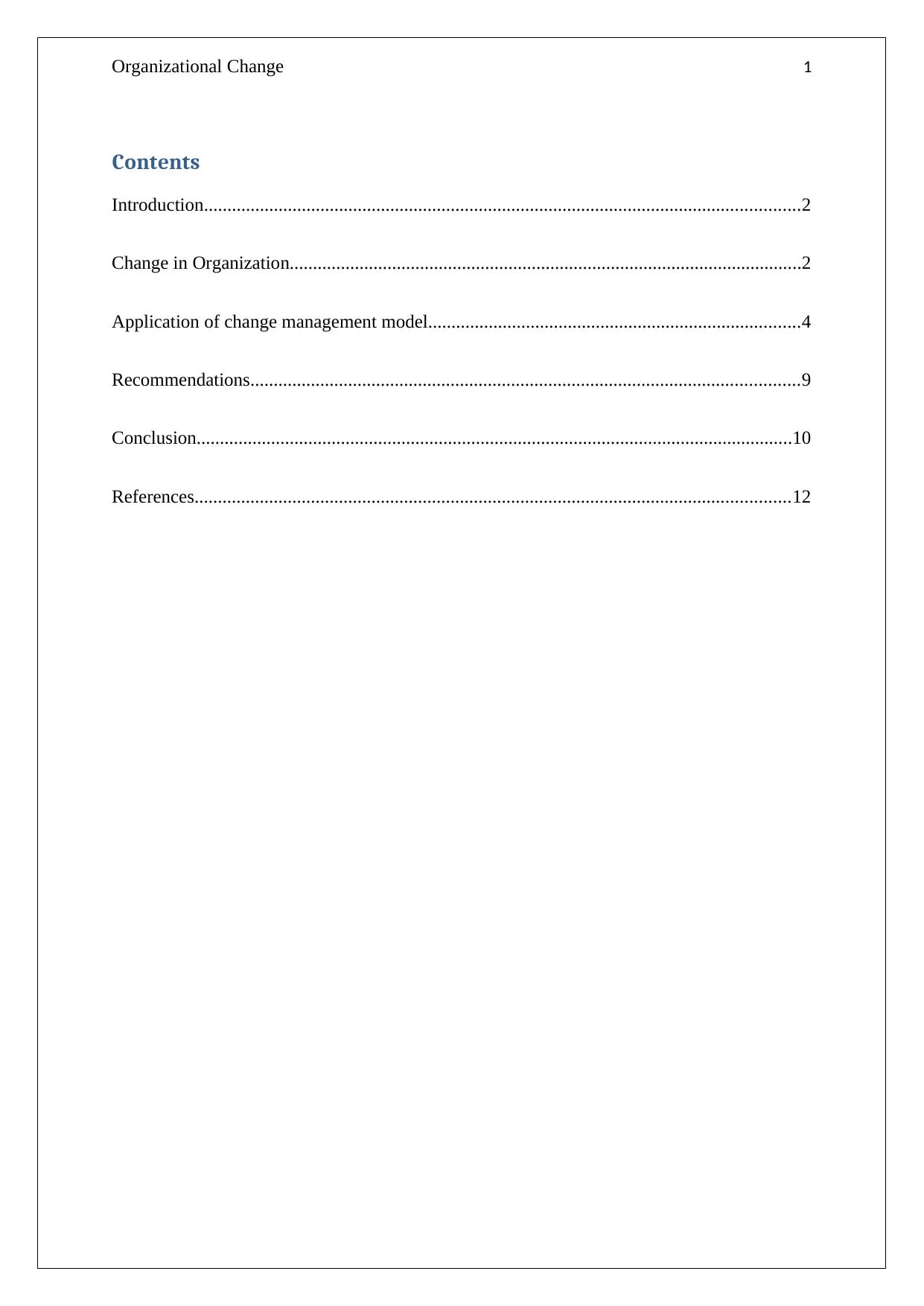
Organizational Change 1
Contents
Introduction................................................................................................................................2
Change in Organization..............................................................................................................2
Application of change management model................................................................................4
Recommendations......................................................................................................................9
Conclusion................................................................................................................................10
References................................................................................................................................12
Contents
Introduction................................................................................................................................2
Change in Organization..............................................................................................................2
Application of change management model................................................................................4
Recommendations......................................................................................................................9
Conclusion................................................................................................................................10
References................................................................................................................................12
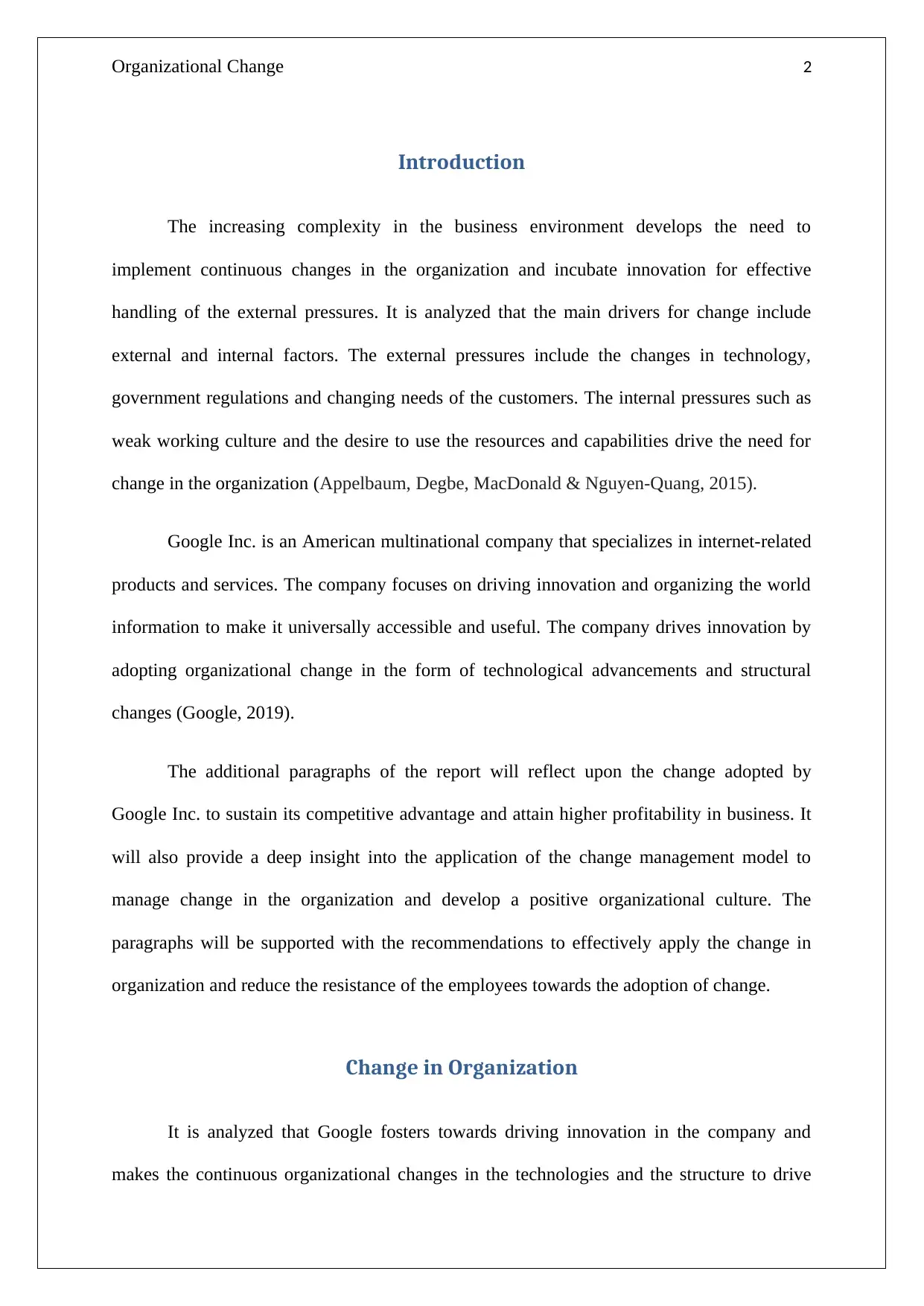
Organizational Change 2
Introduction
The increasing complexity in the business environment develops the need to
implement continuous changes in the organization and incubate innovation for effective
handling of the external pressures. It is analyzed that the main drivers for change include
external and internal factors. The external pressures include the changes in technology,
government regulations and changing needs of the customers. The internal pressures such as
weak working culture and the desire to use the resources and capabilities drive the need for
change in the organization (Appelbaum, Degbe, MacDonald & Nguyen-Quang, 2015).
Google Inc. is an American multinational company that specializes in internet-related
products and services. The company focuses on driving innovation and organizing the world
information to make it universally accessible and useful. The company drives innovation by
adopting organizational change in the form of technological advancements and structural
changes (Google, 2019).
The additional paragraphs of the report will reflect upon the change adopted by
Google Inc. to sustain its competitive advantage and attain higher profitability in business. It
will also provide a deep insight into the application of the change management model to
manage change in the organization and develop a positive organizational culture. The
paragraphs will be supported with the recommendations to effectively apply the change in
organization and reduce the resistance of the employees towards the adoption of change.
Change in Organization
It is analyzed that Google fosters towards driving innovation in the company and
makes the continuous organizational changes in the technologies and the structure to drive
Introduction
The increasing complexity in the business environment develops the need to
implement continuous changes in the organization and incubate innovation for effective
handling of the external pressures. It is analyzed that the main drivers for change include
external and internal factors. The external pressures include the changes in technology,
government regulations and changing needs of the customers. The internal pressures such as
weak working culture and the desire to use the resources and capabilities drive the need for
change in the organization (Appelbaum, Degbe, MacDonald & Nguyen-Quang, 2015).
Google Inc. is an American multinational company that specializes in internet-related
products and services. The company focuses on driving innovation and organizing the world
information to make it universally accessible and useful. The company drives innovation by
adopting organizational change in the form of technological advancements and structural
changes (Google, 2019).
The additional paragraphs of the report will reflect upon the change adopted by
Google Inc. to sustain its competitive advantage and attain higher profitability in business. It
will also provide a deep insight into the application of the change management model to
manage change in the organization and develop a positive organizational culture. The
paragraphs will be supported with the recommendations to effectively apply the change in
organization and reduce the resistance of the employees towards the adoption of change.
Change in Organization
It is analyzed that Google fosters towards driving innovation in the company and
makes the continuous organizational changes in the technologies and the structure to drive
⊘ This is a preview!⊘
Do you want full access?
Subscribe today to unlock all pages.

Trusted by 1+ million students worldwide
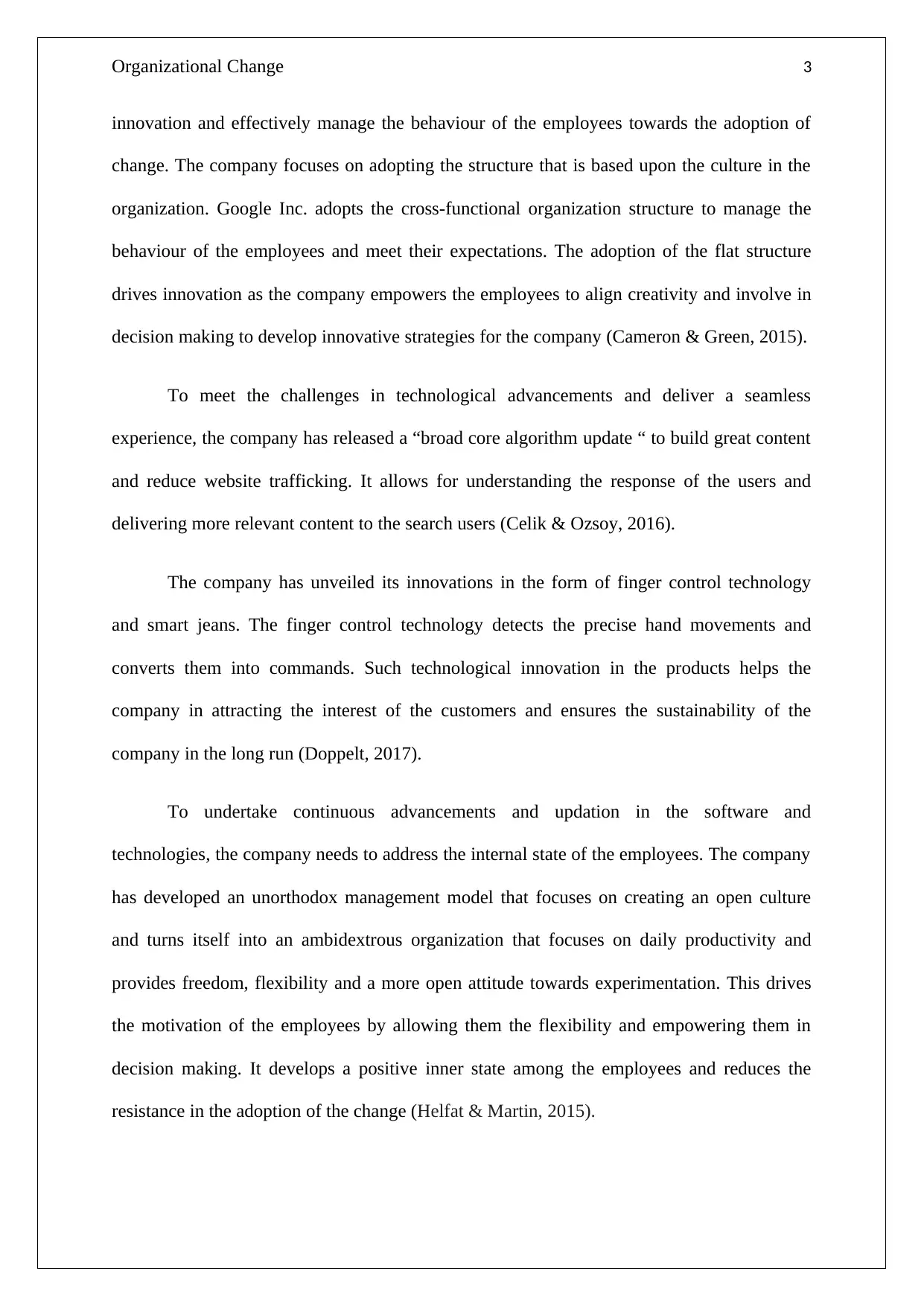
Organizational Change 3
innovation and effectively manage the behaviour of the employees towards the adoption of
change. The company focuses on adopting the structure that is based upon the culture in the
organization. Google Inc. adopts the cross-functional organization structure to manage the
behaviour of the employees and meet their expectations. The adoption of the flat structure
drives innovation as the company empowers the employees to align creativity and involve in
decision making to develop innovative strategies for the company (Cameron & Green, 2015).
To meet the challenges in technological advancements and deliver a seamless
experience, the company has released a “broad core algorithm update “ to build great content
and reduce website trafficking. It allows for understanding the response of the users and
delivering more relevant content to the search users (Celik & Ozsoy, 2016).
The company has unveiled its innovations in the form of finger control technology
and smart jeans. The finger control technology detects the precise hand movements and
converts them into commands. Such technological innovation in the products helps the
company in attracting the interest of the customers and ensures the sustainability of the
company in the long run (Doppelt, 2017).
To undertake continuous advancements and updation in the software and
technologies, the company needs to address the internal state of the employees. The company
has developed an unorthodox management model that focuses on creating an open culture
and turns itself into an ambidextrous organization that focuses on daily productivity and
provides freedom, flexibility and a more open attitude towards experimentation. This drives
the motivation of the employees by allowing them the flexibility and empowering them in
decision making. It develops a positive inner state among the employees and reduces the
resistance in the adoption of the change (Helfat & Martin, 2015).
innovation and effectively manage the behaviour of the employees towards the adoption of
change. The company focuses on adopting the structure that is based upon the culture in the
organization. Google Inc. adopts the cross-functional organization structure to manage the
behaviour of the employees and meet their expectations. The adoption of the flat structure
drives innovation as the company empowers the employees to align creativity and involve in
decision making to develop innovative strategies for the company (Cameron & Green, 2015).
To meet the challenges in technological advancements and deliver a seamless
experience, the company has released a “broad core algorithm update “ to build great content
and reduce website trafficking. It allows for understanding the response of the users and
delivering more relevant content to the search users (Celik & Ozsoy, 2016).
The company has unveiled its innovations in the form of finger control technology
and smart jeans. The finger control technology detects the precise hand movements and
converts them into commands. Such technological innovation in the products helps the
company in attracting the interest of the customers and ensures the sustainability of the
company in the long run (Doppelt, 2017).
To undertake continuous advancements and updation in the software and
technologies, the company needs to address the internal state of the employees. The company
has developed an unorthodox management model that focuses on creating an open culture
and turns itself into an ambidextrous organization that focuses on daily productivity and
provides freedom, flexibility and a more open attitude towards experimentation. This drives
the motivation of the employees by allowing them the flexibility and empowering them in
decision making. It develops a positive inner state among the employees and reduces the
resistance in the adoption of the change (Helfat & Martin, 2015).
Paraphrase This Document
Need a fresh take? Get an instant paraphrase of this document with our AI Paraphraser

Organizational Change 4
The company applies a proactive approach towards the adoption of change by
focusing on the individuals and liberates them the power to innovate by delivering creative
solutions for the company. The adoption of a people-centric approach helps in developing the
organizational culture where the managers trust the employees and ensure more transparency
and openness in the business operations. It focuses on recruiting the right employees who are
able to handle the pressure of continuous change and possess the skills to delegate a high
level of empowerment. The company also focuses on reducing unnecessary bureaucratic
features and promotes openness in communication and collaboration among the employees.
This is turn creates a positive impact on the psychology of the employees and further
encourages them to drive innovation in an organization (Hayes, 2018).
In order to implement continuous organizational changes, Google Inc. focuses on
creating a stimulating work environment where the employees possess the skills to drive
creative solutions and the company accepts the mistakes of the employees during
experimentation. It allows the employees to undertake the risk and be more committed to
driving innovation in an organization. It boosts the morale of the employees and reduces the
fear of change (Pangarkar, 2015).
Application of change management model
It is analyzed that 50 % of the members understand why the change is required in the
company and 50% of the members get inspired after the implementation of change. Google
Inc. faced the challenge of One-third failures of the organizational changes so the company
has developed a new approach and maintains the fluidity in its structures to support the
constant change in its business. To address the changes in the organization the company has
focused on adopting the four-step approach known as “change rules” (Pu & Schramm, 2018).
The company applies a proactive approach towards the adoption of change by
focusing on the individuals and liberates them the power to innovate by delivering creative
solutions for the company. The adoption of a people-centric approach helps in developing the
organizational culture where the managers trust the employees and ensure more transparency
and openness in the business operations. It focuses on recruiting the right employees who are
able to handle the pressure of continuous change and possess the skills to delegate a high
level of empowerment. The company also focuses on reducing unnecessary bureaucratic
features and promotes openness in communication and collaboration among the employees.
This is turn creates a positive impact on the psychology of the employees and further
encourages them to drive innovation in an organization (Hayes, 2018).
In order to implement continuous organizational changes, Google Inc. focuses on
creating a stimulating work environment where the employees possess the skills to drive
creative solutions and the company accepts the mistakes of the employees during
experimentation. It allows the employees to undertake the risk and be more committed to
driving innovation in an organization. It boosts the morale of the employees and reduces the
fear of change (Pangarkar, 2015).
Application of change management model
It is analyzed that 50 % of the members understand why the change is required in the
company and 50% of the members get inspired after the implementation of change. Google
Inc. faced the challenge of One-third failures of the organizational changes so the company
has developed a new approach and maintains the fluidity in its structures to support the
constant change in its business. To address the changes in the organization the company has
focused on adopting the four-step approach known as “change rules” (Pu & Schramm, 2018).
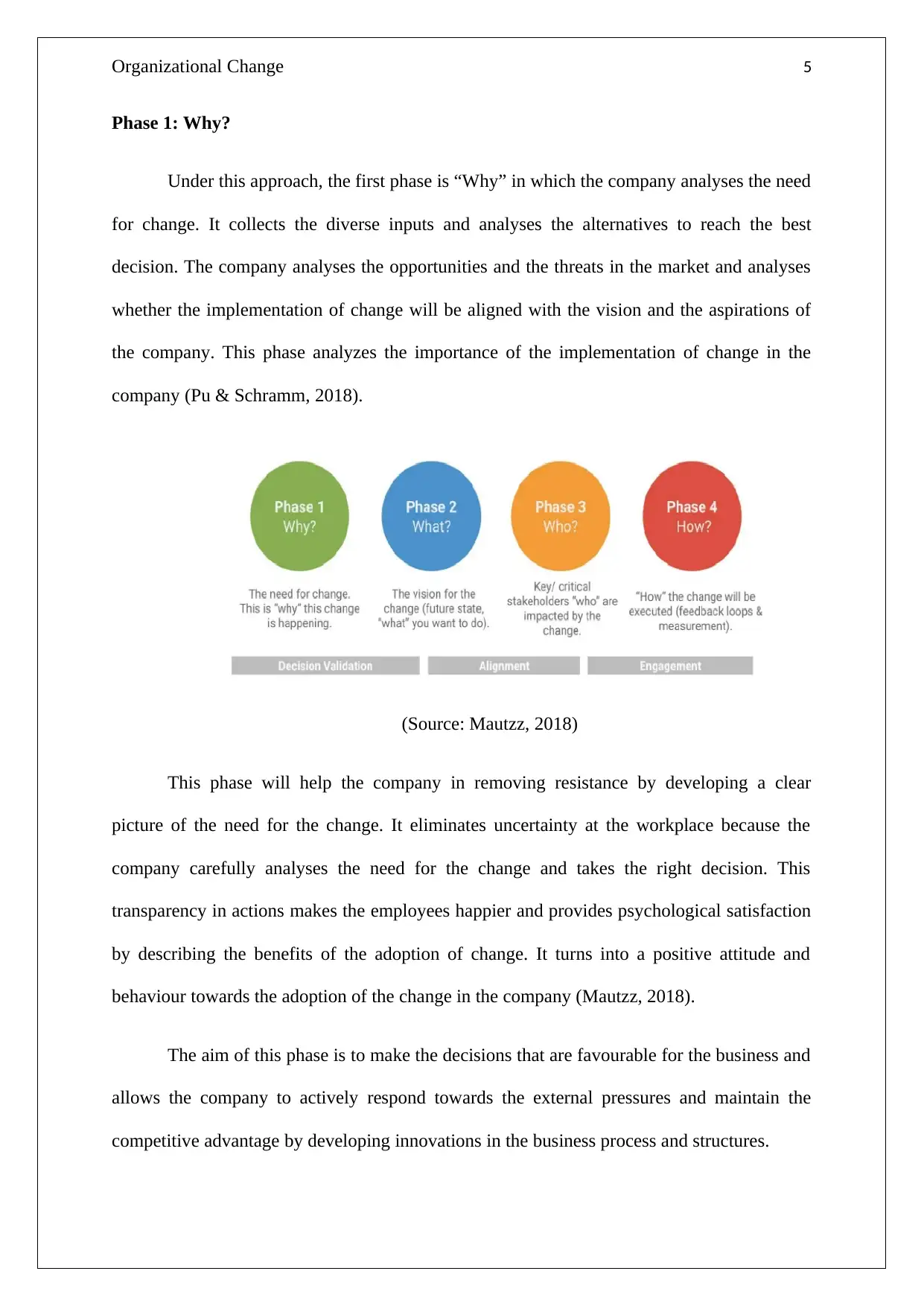
Organizational Change 5
Phase 1: Why?
Under this approach, the first phase is “Why” in which the company analyses the need
for change. It collects the diverse inputs and analyses the alternatives to reach the best
decision. The company analyses the opportunities and the threats in the market and analyses
whether the implementation of change will be aligned with the vision and the aspirations of
the company. This phase analyzes the importance of the implementation of change in the
company (Pu & Schramm, 2018).
(Source: Mautzz, 2018)
This phase will help the company in removing resistance by developing a clear
picture of the need for the change. It eliminates uncertainty at the workplace because the
company carefully analyses the need for the change and takes the right decision. This
transparency in actions makes the employees happier and provides psychological satisfaction
by describing the benefits of the adoption of change. It turns into a positive attitude and
behaviour towards the adoption of the change in the company (Mautzz, 2018).
The aim of this phase is to make the decisions that are favourable for the business and
allows the company to actively respond towards the external pressures and maintain the
competitive advantage by developing innovations in the business process and structures.
Phase 1: Why?
Under this approach, the first phase is “Why” in which the company analyses the need
for change. It collects the diverse inputs and analyses the alternatives to reach the best
decision. The company analyses the opportunities and the threats in the market and analyses
whether the implementation of change will be aligned with the vision and the aspirations of
the company. This phase analyzes the importance of the implementation of change in the
company (Pu & Schramm, 2018).
(Source: Mautzz, 2018)
This phase will help the company in removing resistance by developing a clear
picture of the need for the change. It eliminates uncertainty at the workplace because the
company carefully analyses the need for the change and takes the right decision. This
transparency in actions makes the employees happier and provides psychological satisfaction
by describing the benefits of the adoption of change. It turns into a positive attitude and
behaviour towards the adoption of the change in the company (Mautzz, 2018).
The aim of this phase is to make the decisions that are favourable for the business and
allows the company to actively respond towards the external pressures and maintain the
competitive advantage by developing innovations in the business process and structures.
⊘ This is a preview!⊘
Do you want full access?
Subscribe today to unlock all pages.

Trusted by 1+ million students worldwide

Organizational Change 6
Phase 2: What?
The next phase under this approach is “What” under which the company gets the clear
crystal picture of the desired state in the future and helps in analysing the success or the
failure looks like during post-change. Under this step, the company analyses the contrary
options available that will help in increasing the confidence of the recipients. It provides a
clear picture of whether the change will provide a new strategic direction to the company and
will improve the future state of the business (Mautzz, 2018).
The adoption of this phase reduces the fear of loss in the future and clearly states that
whether the future outcomes will be handled by the company. It helps the company in
analyzing the clear state in future. The clear picture of the desired state will help the company
in gaining the confidence of the employees towards the adoption of change and improves
their internal state (Keane, Ontaneda, Martino, & Cain, 2018).
Under this Google analyses what changes to be implemented in the company and
specifies what will be the consequences in the future. Describing the desired state of future
helps in boosting the morale of the employees because they will gain insight about the
benefits the company will receive from the adoption of change and will also remove the
uncertainties that lie in the adoption of change (Rosemann & Vom Brocke, 2015).
Phase 3: Who
This is the third phase that reflects that who will be impacted by the change and
analyses the individuals who will lead the change. The main focus under this phase is to
manage the resistance and convert them into transition. It specifies that the employees do not
enrol in implementing however the company specifies the weighs in the adoption of change.
It focuses on converting the fear of employees and analyzing the key stakeholders who will
Phase 2: What?
The next phase under this approach is “What” under which the company gets the clear
crystal picture of the desired state in the future and helps in analysing the success or the
failure looks like during post-change. Under this step, the company analyses the contrary
options available that will help in increasing the confidence of the recipients. It provides a
clear picture of whether the change will provide a new strategic direction to the company and
will improve the future state of the business (Mautzz, 2018).
The adoption of this phase reduces the fear of loss in the future and clearly states that
whether the future outcomes will be handled by the company. It helps the company in
analyzing the clear state in future. The clear picture of the desired state will help the company
in gaining the confidence of the employees towards the adoption of change and improves
their internal state (Keane, Ontaneda, Martino, & Cain, 2018).
Under this Google analyses what changes to be implemented in the company and
specifies what will be the consequences in the future. Describing the desired state of future
helps in boosting the morale of the employees because they will gain insight about the
benefits the company will receive from the adoption of change and will also remove the
uncertainties that lie in the adoption of change (Rosemann & Vom Brocke, 2015).
Phase 3: Who
This is the third phase that reflects that who will be impacted by the change and
analyses the individuals who will lead the change. The main focus under this phase is to
manage the resistance and convert them into transition. It specifies that the employees do not
enrol in implementing however the company specifies the weighs in the adoption of change.
It focuses on converting the fear of employees and analyzing the key stakeholders who will
Paraphrase This Document
Need a fresh take? Get an instant paraphrase of this document with our AI Paraphraser
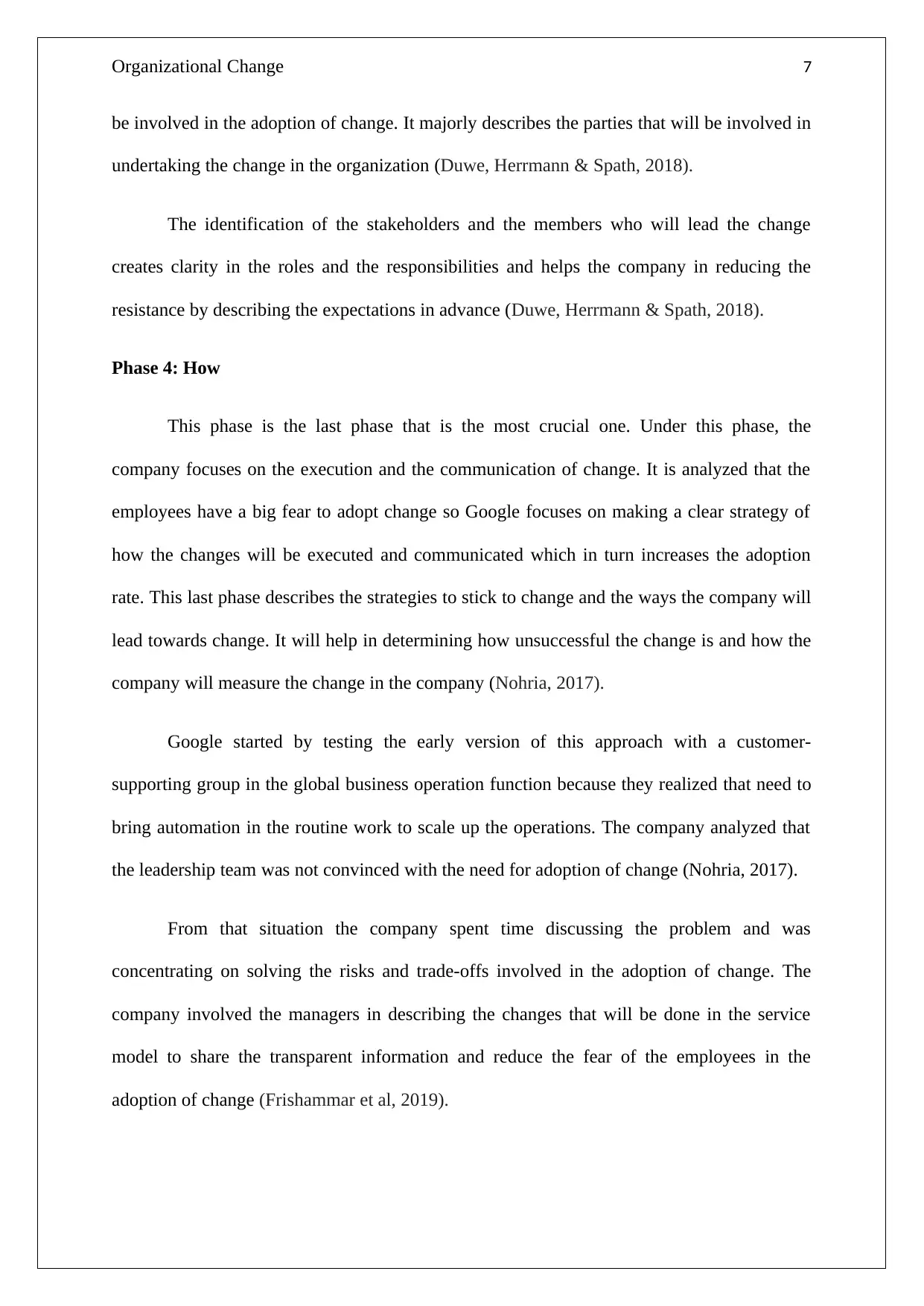
Organizational Change 7
be involved in the adoption of change. It majorly describes the parties that will be involved in
undertaking the change in the organization (Duwe, Herrmann & Spath, 2018).
The identification of the stakeholders and the members who will lead the change
creates clarity in the roles and the responsibilities and helps the company in reducing the
resistance by describing the expectations in advance (Duwe, Herrmann & Spath, 2018).
Phase 4: How
This phase is the last phase that is the most crucial one. Under this phase, the
company focuses on the execution and the communication of change. It is analyzed that the
employees have a big fear to adopt change so Google focuses on making a clear strategy of
how the changes will be executed and communicated which in turn increases the adoption
rate. This last phase describes the strategies to stick to change and the ways the company will
lead towards change. It will help in determining how unsuccessful the change is and how the
company will measure the change in the company (Nohria, 2017).
Google started by testing the early version of this approach with a customer-
supporting group in the global business operation function because they realized that need to
bring automation in the routine work to scale up the operations. The company analyzed that
the leadership team was not convinced with the need for adoption of change (Nohria, 2017).
From that situation the company spent time discussing the problem and was
concentrating on solving the risks and trade-offs involved in the adoption of change. The
company involved the managers in describing the changes that will be done in the service
model to share the transparent information and reduce the fear of the employees in the
adoption of change (Frishammar et al, 2019).
be involved in the adoption of change. It majorly describes the parties that will be involved in
undertaking the change in the organization (Duwe, Herrmann & Spath, 2018).
The identification of the stakeholders and the members who will lead the change
creates clarity in the roles and the responsibilities and helps the company in reducing the
resistance by describing the expectations in advance (Duwe, Herrmann & Spath, 2018).
Phase 4: How
This phase is the last phase that is the most crucial one. Under this phase, the
company focuses on the execution and the communication of change. It is analyzed that the
employees have a big fear to adopt change so Google focuses on making a clear strategy of
how the changes will be executed and communicated which in turn increases the adoption
rate. This last phase describes the strategies to stick to change and the ways the company will
lead towards change. It will help in determining how unsuccessful the change is and how the
company will measure the change in the company (Nohria, 2017).
Google started by testing the early version of this approach with a customer-
supporting group in the global business operation function because they realized that need to
bring automation in the routine work to scale up the operations. The company analyzed that
the leadership team was not convinced with the need for adoption of change (Nohria, 2017).
From that situation the company spent time discussing the problem and was
concentrating on solving the risks and trade-offs involved in the adoption of change. The
company involved the managers in describing the changes that will be done in the service
model to share the transparent information and reduce the fear of the employees in the
adoption of change (Frishammar et al, 2019).
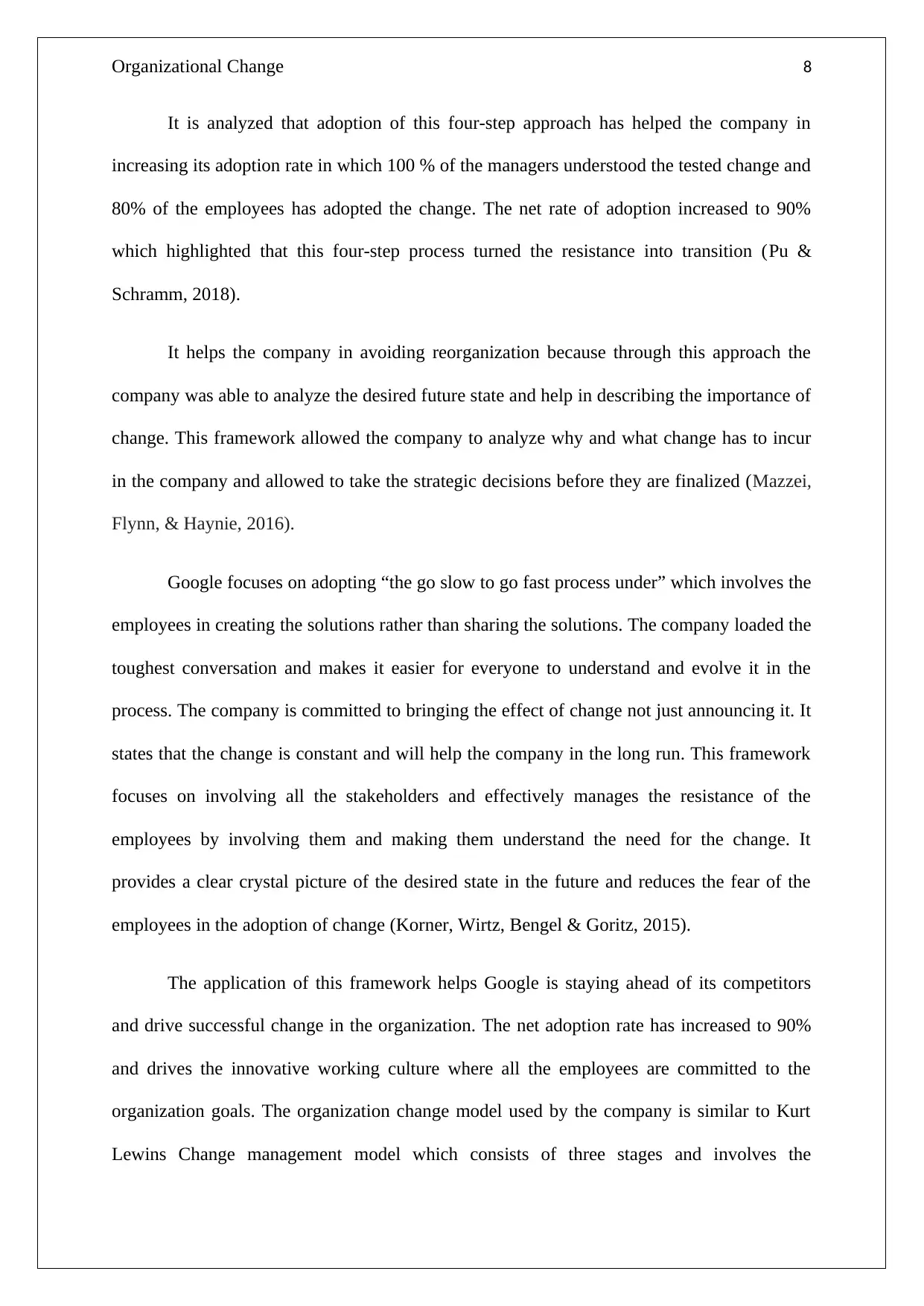
Organizational Change 8
It is analyzed that adoption of this four-step approach has helped the company in
increasing its adoption rate in which 100 % of the managers understood the tested change and
80% of the employees has adopted the change. The net rate of adoption increased to 90%
which highlighted that this four-step process turned the resistance into transition (Pu &
Schramm, 2018).
It helps the company in avoiding reorganization because through this approach the
company was able to analyze the desired future state and help in describing the importance of
change. This framework allowed the company to analyze why and what change has to incur
in the company and allowed to take the strategic decisions before they are finalized (Mazzei,
Flynn, & Haynie, 2016).
Google focuses on adopting “the go slow to go fast process under” which involves the
employees in creating the solutions rather than sharing the solutions. The company loaded the
toughest conversation and makes it easier for everyone to understand and evolve it in the
process. The company is committed to bringing the effect of change not just announcing it. It
states that the change is constant and will help the company in the long run. This framework
focuses on involving all the stakeholders and effectively manages the resistance of the
employees by involving them and making them understand the need for the change. It
provides a clear crystal picture of the desired state in the future and reduces the fear of the
employees in the adoption of change (Korner, Wirtz, Bengel & Goritz, 2015).
The application of this framework helps Google is staying ahead of its competitors
and drive successful change in the organization. The net adoption rate has increased to 90%
and drives the innovative working culture where all the employees are committed to the
organization goals. The organization change model used by the company is similar to Kurt
Lewins Change management model which consists of three stages and involves the
It is analyzed that adoption of this four-step approach has helped the company in
increasing its adoption rate in which 100 % of the managers understood the tested change and
80% of the employees has adopted the change. The net rate of adoption increased to 90%
which highlighted that this four-step process turned the resistance into transition (Pu &
Schramm, 2018).
It helps the company in avoiding reorganization because through this approach the
company was able to analyze the desired future state and help in describing the importance of
change. This framework allowed the company to analyze why and what change has to incur
in the company and allowed to take the strategic decisions before they are finalized (Mazzei,
Flynn, & Haynie, 2016).
Google focuses on adopting “the go slow to go fast process under” which involves the
employees in creating the solutions rather than sharing the solutions. The company loaded the
toughest conversation and makes it easier for everyone to understand and evolve it in the
process. The company is committed to bringing the effect of change not just announcing it. It
states that the change is constant and will help the company in the long run. This framework
focuses on involving all the stakeholders and effectively manages the resistance of the
employees by involving them and making them understand the need for the change. It
provides a clear crystal picture of the desired state in the future and reduces the fear of the
employees in the adoption of change (Korner, Wirtz, Bengel & Goritz, 2015).
The application of this framework helps Google is staying ahead of its competitors
and drive successful change in the organization. The net adoption rate has increased to 90%
and drives the innovative working culture where all the employees are committed to the
organization goals. The organization change model used by the company is similar to Kurt
Lewins Change management model which consists of three stages and involves the
⊘ This is a preview!⊘
Do you want full access?
Subscribe today to unlock all pages.

Trusted by 1+ million students worldwide

Organizational Change 9
employees in the adoption of change. This model also focuses on embracing the change and
keeping it intact for a longer period of time (Elsbach & Stigliani, 2018).
Apart from the application of this four-step process the company needs to address the
change in the organization culture and must resolve the issues faced by the employees
including the misconduct and the harassment at the workplace. It must embrace diversity and
must develop mutual respect or all the members. The company must bring the changes in its
organization policies to promote positive working culture and must focus on providing the
psychological satisfaction to the employees to promote change and collaboration at the
workplace and develop innovative strategies for the growth of the company (Hornstein,
2015).
Recommendations
To embrace the positive change in the organization the company must focus on
adopting the eight-step model under which it must identify the change required and must
develop a solid case study to attract buyers. It must develop the roadmap for the adoption of
change and must gather the relevant information that will help in the adoption of change.
After deriving the information it must focus on developing the open communication culture
and must focus on managing the risk associated with the business and must celebrate the
success with the members to create a positive working culture. It must also focus on the
continuous review and making the changes in the process that helps in driving the business
successfully and achieving the vision and mission of the company (Jones & Van de Ven,
2016).
To reduce the resistance of the employees the company must focus on improving
employee motivation by empowering them and reducing the bureaucratic features at the
employees in the adoption of change. This model also focuses on embracing the change and
keeping it intact for a longer period of time (Elsbach & Stigliani, 2018).
Apart from the application of this four-step process the company needs to address the
change in the organization culture and must resolve the issues faced by the employees
including the misconduct and the harassment at the workplace. It must embrace diversity and
must develop mutual respect or all the members. The company must bring the changes in its
organization policies to promote positive working culture and must focus on providing the
psychological satisfaction to the employees to promote change and collaboration at the
workplace and develop innovative strategies for the growth of the company (Hornstein,
2015).
Recommendations
To embrace the positive change in the organization the company must focus on
adopting the eight-step model under which it must identify the change required and must
develop a solid case study to attract buyers. It must develop the roadmap for the adoption of
change and must gather the relevant information that will help in the adoption of change.
After deriving the information it must focus on developing the open communication culture
and must focus on managing the risk associated with the business and must celebrate the
success with the members to create a positive working culture. It must also focus on the
continuous review and making the changes in the process that helps in driving the business
successfully and achieving the vision and mission of the company (Jones & Van de Ven,
2016).
To reduce the resistance of the employees the company must focus on improving
employee motivation by empowering them and reducing the bureaucratic features at the
Paraphrase This Document
Need a fresh take? Get an instant paraphrase of this document with our AI Paraphraser

Organizational Change 10
workplace. It must focus on taking feedback from the employees and making improvements
in the policies to create a positive working environment and successfully embrace the change
in the workplace (Rahim, 2017).
Google must create an open communication environment and must empathetically
listen to the employees to change their attitude and behaviour towards the adoption of change
and reducing the fear of performing complex job roles and responsibilities. It must develop
effective training programs that will help in developing the skills and the competencies that
allow the employees to strive for innovation in an organization (Lozano, Nummert &
Ceulemans, 2016).
Conclusion
From the above discussion, it is critical to note that the changing complexities and the
increased competition in the business environment have developed the need to embrace
change and develop innovative strategies that ensure the long term sustainability of the
business. It is analyzed from the above that Google focuses on the continuous development of
the innovative strategies and adoption of the latest technologies to deliver a seamless
experience to customers. The company has shifted from conventional organization structure
to unorthodox organization structure that is people-centric and drives open communication
culture for creating a positive working environment.
It adopts the four-step approach that allows the company to convince the members by
understanding the need for the change and describing the desired future state. It helps in
reducing the fear of the employees and has increased the adoption rate to 90%. This approach
helps in embracing the change for a longer period of time and concentrates on involving the
employees for deriving creative solutions for the company.
workplace. It must focus on taking feedback from the employees and making improvements
in the policies to create a positive working environment and successfully embrace the change
in the workplace (Rahim, 2017).
Google must create an open communication environment and must empathetically
listen to the employees to change their attitude and behaviour towards the adoption of change
and reducing the fear of performing complex job roles and responsibilities. It must develop
effective training programs that will help in developing the skills and the competencies that
allow the employees to strive for innovation in an organization (Lozano, Nummert &
Ceulemans, 2016).
Conclusion
From the above discussion, it is critical to note that the changing complexities and the
increased competition in the business environment have developed the need to embrace
change and develop innovative strategies that ensure the long term sustainability of the
business. It is analyzed from the above that Google focuses on the continuous development of
the innovative strategies and adoption of the latest technologies to deliver a seamless
experience to customers. The company has shifted from conventional organization structure
to unorthodox organization structure that is people-centric and drives open communication
culture for creating a positive working environment.
It adopts the four-step approach that allows the company to convince the members by
understanding the need for the change and describing the desired future state. It helps in
reducing the fear of the employees and has increased the adoption rate to 90%. This approach
helps in embracing the change for a longer period of time and concentrates on involving the
employees for deriving creative solutions for the company.

Organizational Change 11
The further paragraphs state the recommendations for improving the organization's
culture and motivating the employees for the successful adoption of change. It emphasizes
that Google must develop training programs to develop the required know-how among the
employees and reduce their resistance towards the adoption of the change in the organization.
The further paragraphs state the recommendations for improving the organization's
culture and motivating the employees for the successful adoption of change. It emphasizes
that Google must develop training programs to develop the required know-how among the
employees and reduce their resistance towards the adoption of the change in the organization.
⊘ This is a preview!⊘
Do you want full access?
Subscribe today to unlock all pages.

Trusted by 1+ million students worldwide
1 out of 15
Related Documents
Your All-in-One AI-Powered Toolkit for Academic Success.
+13062052269
info@desklib.com
Available 24*7 on WhatsApp / Email
![[object Object]](/_next/static/media/star-bottom.7253800d.svg)
Unlock your academic potential
Copyright © 2020–2025 A2Z Services. All Rights Reserved. Developed and managed by ZUCOL.





